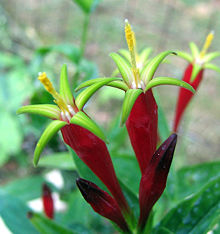Spigelia marilandica
| Woodland pinkroot | |
|---|---|

| |
| Scientific classification | |
| Kingdom: | Plantae |
| Clade: | Tracheophytes |
| Clade: | Angiosperms |
| Clade: | Eudicots |
| Clade: | Asterids |
| Order: | Gentianales |
| Family: | Loganiaceae |
| Genus: | Spigelia |
| Species: | S. marilandica
|
| Binomial name | |
| Spigelia marilandica | |

| |
| US distribution by state of Spigelia marilandica | |
Spigelia marilandica, the woodland pinkroot[1] or Indian pink[2][3] is a herbacious perennial wildflower in the Loganiaceae family[2] native to inland areas of the Southeastern and Midwestern United States.[3]
It flowers in late spring and early summer[3] and tends to be found in low moist woods, ravines, or stream banks in partial or full shade.[2] The flowers are red, erect, tubes with a star-shaped yellow center at the tip.[4] It will grow 30–61 cm (1–2 ft) high with a spread of 15–46 cm (0.5–1.5 ft).[2]

It is used as an ornamental plant,[5] more popular in the UK and Europe than its native U.S.[4]
Its dried roots are used as an anthelmintic (dewormer), and are followed by a saline aperient to avoid unpleasant side effects and ensure that the toxic root is expelled along with the worms.[6] The roots are also a narcotic hallucinogen, but the alkaloid spigiline, which is largely responsible for both its hallucinogenic and medicinal action, can cause increased heart action, vertigo, convulsions and death if overdosed.[6]
References
[edit]- ^ USDA, NRCS (n.d.). "Spigelia marilandica". The PLANTS Database (plants.usda.gov). Greensboro, North Carolina: National Plant Data Team. Retrieved 25 November 2015.
- ^ a b c d "Spigelia marilandica" at the Missouri Botanical Garden website. Retrieved 1 January 2023.
- ^ a b c Spigelia marilandica, NC State Extension
- ^ a b Tony Avent. "Plant Profile: Spigelia marilandica (Indian Pink)." Plants for a Future website. 30 April 2013. Retrieved 1 January 2023.
- ^ Pink, A. (2004). Gardening for the Million. Project Gutenberg Literary Archive Foundation.
- ^ a b "Spigelia marilandica" at Plants for a Future website. Retrieved 1 January 2023.
External links
[edit]- Spigelia marilandica at Missouri Plants website with extensive photos
